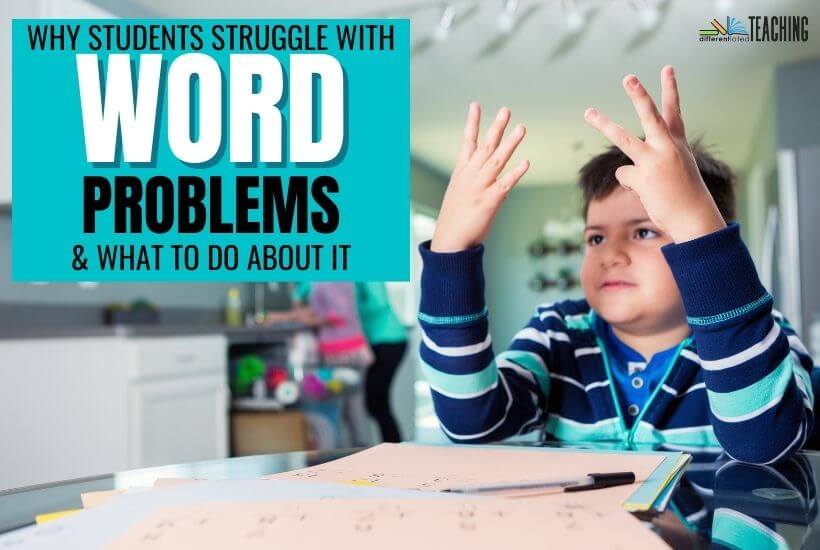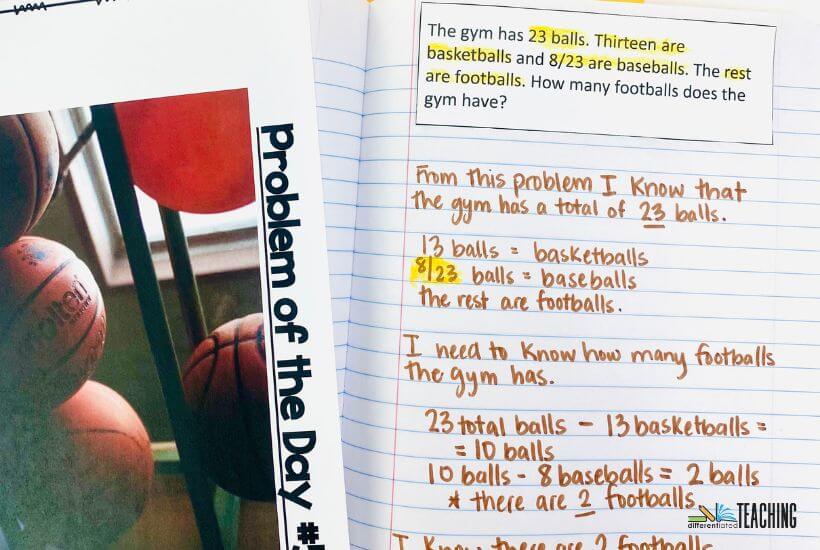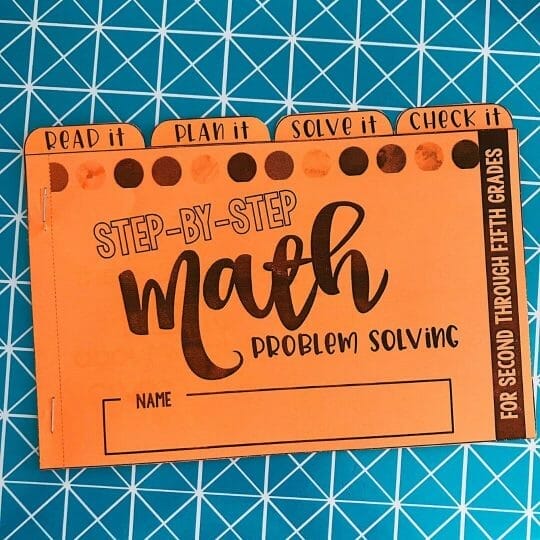Why do students struggle with math word problems? (And What to Try)
Word problems can be a real challenge for students of all ages. While some learners quickly grasp the concepts and transfer these skills to multi-step word problems, others struggle with even the most straightforward, basic word problems. As teachers, we must understand why this is so to help students succeed.

In this blog post, we’ll explore common issues that cause difficulty when solving word problems and potential solutions that can assist learners in becoming more proficient problem-solvers. So, let’s dive into what makes word problems so tricky and how you can help your students master them!
How to Help Learners Conquer Word Problems: Common Challenges & Solutions
Problem #1: Students have difficulty reading & understanding the problems.
Word problems can be a daunting task for students of all ages. Solving math problems demands students to comprehend mathematical terms and have solid decoding abilities. If either of these skills is lacking, students may need help understanding the meaning behind certain words and phrases.
Considering that only a few sentences can determine the solution to a problem, it is essential to comprehend the language used in word problems. Yet, only 32% of 4th graders are proficient readers, according to the National Assessment of Educational Progress.
The challenge of comprehending the language in word problems is not only difficult for students who struggle with reading but can also be an obstacle for high-achieving math students. Often, these students know how to solve a problem but need help understanding what the problem is asking.
Word problems further complicate matters due to their use of language that’s different from how we communicate.
For example, students may read a problem that says, “Sarah is baking a pie for her grandmother’s birthday. She needs 7 apples for the recipe. At the store, apples are $2 a piece. If she has $11, will she have enough money to make the pie?”
Students must decode the words and phrases used to understand what the problem is asking them.
Solution: Provide word problems in audio formats & consider how you can incorporate explicit teaching into your math problem-solving routine.
One common strategy for addressing this is to read the problems aloud. Technology can help with this. Recording and storing problems where students can listen to them repeatedly can be helpful. However, you will need to teach your students to use this technology purposefully to help them better understand the word problems they are tackling. Without proper instruction, these recorded problems are no more helpful than reading the problems themselves.
However, this only addresses issues with decoding. It is essential to explain to students the meaning of words and math terms used in questions. A Problem of the Day format offers an excellent opportunity to deeply discuss a single problem with students without taking over your entire math lesson.
Explaining these concepts helps students build a stronger foundation for understanding word problems and increases their math comprehension.
Problem #2: Students have gaps in vocabulary that would help with math word problems.
Sometimes, story problems require students to have an understanding of math vocabulary. When students don’t wholly understand math vocabulary, they struggle to understand what the problems are asking.
This is more than just decoding!
Even if they can read these words, they may need help understanding how to solve the problems. A strong foundation in math vocabulary is integral to any math classroom.
Solution: Explicitly teach and review math vocabulary regularly.
Ensure that students have a strong foundation in math vocabulary by explicitly teaching terms and concepts. This can be done through direct instruction, visual representations, and activities reinforcing the concepts.
Review these terms regularly throughout the year to ensure they stay fresh in students’ minds.
Problem #3: Students lack efficient & effective strategies.
Often, students are taught to use keywords early on. However, as problems become more complex, this quickly becomes an ineffective and inefficient strategy For addressing multi-step word problems.
Research has shown keywords often misdirect students’ efforts and derail problem-solving with math word problems.
As a result, many state tests now purposefully include tricky problems designed to fool students who have been taught keywords as a problem-solving strategy.
Solution: Teach a problem-solving strategy, like CUBES, that helps students break the problem down efficiently.
While keywords are ineffective, giving students a framework for breaking down word problems and identifying the information that CAN help them is a great way to support their problem-solving efforts.
The CUBES strategy (Circle, Underline, Box, Evaluate, Solve) can help older students with math word problems. This strategy helps them break down problems into manageable steps that make sense to them.
Problem #4: Difficulty mapping out and visualizing the story behind each problem can lead to confusion in solving for an answer.
Another familiar struggle students face when solving word problems is difficulty mapping out and visualizing the story behind each problem. This can lead to confusion in solving for an answer because students may be unable to see how all the pieces fit together. In other words, they don’t have a complete understanding of the context of the problem.
Solution: Give students an active way to create a picture of what the problem is asking them.
Diagrams with labels, breaking the problem into simpler parts, and making a step-by-step plan with math word problems can help students understand the situation. Having them explain the story in their own words helps them clarify what they’re trying to solve.
Encourage students who automatically add all the numbers to slow down and process the question with numberless word problems.
A numberless word problem is a story problem that does not include numbers. Instead, students are asked to analyze the problem without numbers before they are given the numbers to solve. This can help students notice patterns in the problem and determine what operations will be necessary for solving it. Adding these types of word problems to your instructional routine can be a great way to help students slow down and focus on understanding the scenario being presented in the problem.
By providing students with different ways to visualize word problems, we can increase their chances of success and provide meaningful math instruction. Equipping them with the right tools and strategies gives them a better chance of tackling any difficult word problem they may encounter.
Problem #5: Those with poor numeracy skills are disadvantaged when attempting to solve math word problems.
Computational fluency is a common buzzword in math circles these days. We often discuss whether students know their math facts. However, math fact fluency becomes even more critical when students dive into more challenging word problems.
According to cognitive load theory, students focusing on rote processes such as basic facts have fewer mental resources left for higher-level thinking and processing.
In other words, the more mental energy it takes to work through the first step of a two-step problem, the less likely the student will have the resources to persist in accurately making it through the rest of the problem.
Solution: Build fact fluency practice into your routine in fun, engaging ways.
Fact fluency practice doesn’t have to be boring, but it is integral to being an effective mathematician. Therefore, finding ways to build it into your math class is essential.
Here are some of my favorite online games that students love: 30+ Awesome Online Games for Math Fact Practice.
Problem #6: Students lack experience or are only provided with structured word problem practice.
Some curricula only include problems that follow a specific pattern or directly connect to the skill learned in a given lesson. However, formulaic word problems, where students follow a specific set of steps repeatedly, promote complacency.
Students begin to approach every word problem with the same steps. Soon they are grabbing numbers instead of taking the time to comprehend the problem and how best to address it.
Additionally, many word problems require students to apply knowledge from multiple different units to solve the problem. This can be challenging for students still working on mastering previously taught skills. It overwhelms those who have missed chunks of their instruction due to illness or being pulled from instruction.
As a result, these word problems often begin to feel impossible.
Solution: Incorporate variety into your problem-solving and allow for productive struggle.
Students need to be provided with an opportunity to approach a variety of different problems across time. They need to see problems that come in various formats. They need uniquely worded problems. This novelty prevents them from sticking with a rote set of strategies. The goal is to get them critically thinking about the problem at hand.
Offering variety builds confidence, competence, and the ability to address any problem they are given. Many students lack confidence in word problems. Varied experience reduces fears and helps students develop a bank of strategies to overcome barriers when complex problems arise.
To help foster independence, you can also support students through the gradual release process. Provide learners with a step-by-step guide to ensure they have completed the problem-solving process’s critical steps when you aren’t doing problems with them. This can help boost their confidence and reduce the risk of careless mistakes.
I’ve created a free mini-book for students with guiding questions and steps to help them independently complete word problems.
Building the math problem solver’s toolbox
Word problems can be difficult for learners, but with the right strategies and resources, teachers can help their students learn to approach word problems confidently. By providing a variety of word problems that come in various formats and require different steps to solve, teachers can allow their students to develop problem-solving skills and build confidence when addressing any problem they are given.
Don’t forget to grab the free problem solver’s guide!
I hope you found this post helpful. Problem-solving is an essential skill for learners. Learn more about word problems or check out my Daily Problem Solving for engaging and meaningful word problem practice.












